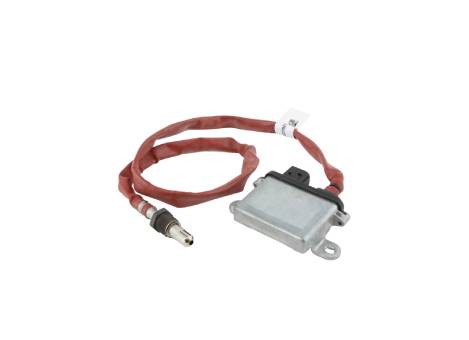
Particulate matter (PM) is one of the most dangerous pollutants for the human body. These tiny particles, typically smaller than 10 microns, can be inhaled into the lungs and cause severe respiratory problems. Therefore, detecting and controlling these particles in emission systems is very important.
A high-quality particulate matter sensor can help monitor the concentration of soot in exhaust systems, informing about the need for action and ensuring regulatory compliance. At SMP Engineered Solutions, we design high-performing particulate matter sensors for a wide range of applications.
Particulate Matter Sensors Explained
When hydrocarbons do not burn completely, they release soot and impure carbon particles, which can be a health hazard. The particles can be easily inhaled and get deeper into the lungs, causing respiratory problems. Particulate matter sensors are devices used to detect and measure the amount of these particles.
Diesel engines use diesel particulate filters (DPF) to capture the impure carbon particles, preventing their release into the environment. Particulate matter sensors help estimate the amount of soot accumulated on a DPF to devise the appropriate filter regeneration strategies, such as the frequency and timing for regeneration. Overestimating the soot mass may lead to too much regeneration, which causes fuel waste and accelerates system wear-out, while underestimating soot buildup may lead to excessive heat, premature aging, DPF deterioration, or total failure.
Particulate matter sensors also detect DPF failure, which may result from excessive PM emissions and activate an OBD fault signal. OBD regulations require more diagnostic measures of the emission system, e.g. checking the tailgate PM emissions and DPF filtration efficiency.
Types of Soot Sensors
As concerns about air quality increase, particulate matter sensors will only become an even more important tool in reducing air pollution. Soot sensors fall into four categories depending on the sensing technology they use. These include:
- Differential pressure (delta P): These sensors estimate the DPF soot load based on the pressure drop increase in the filter.
- Radiofrequency (RF): These sensors calculate the DPF load based on how accumulated soot absorbs a microwave signal.
- Accumulating electrode: These types of sensors measure an electrode’s change in electrical resistance based on time-sensitive soot deposition.
- Electric charge: Electric charge sensors use particle charging techniques to determine particle concentrations in the exhaust gas in real time.
Advantages of Particulate Matter Sensors
Particulate matter sensors offer many advantages, including:
- Portability: Due to their compact size and portability, particulate matter sensors can be used in many environments.
- Accuracy: Users can rely on the consistent, accurate data offered by particulate matter sensors, helping them make informed decisions regarding the environment and public health.
- Real-Time Monitoring: The sensors’ real-time tracking of air quality offers crucial, timely information to researchers, policymakers, and citizens. Multiple sensors can be installed and operated at once, allowing users to choose when, where, and how they monitor air pollution.
- Cost-Effective: Particulate matter sensors are relatively low-cost investments, which makes them accessible to more individuals and organizations.
- User-Friendly: Particulate matter sensors do not require specialized knowledge or extensive training to operate.
- Intervention: Authorities can use soot sensors to establish sources of pollution and take prompt corrective action to enhance air quality.
- Health Benefits: People can use data from soot sensors to know when to avoid certain outdoor environments or take precautions such as wearing a mask.
Applications of Particulate Matter Sensors
SMP Engineered Solutions specializes in custom solutions for on- and off-highway vehicles. Our major on-highway vehicle sectors include passenger and commercial vehicles, and major off-highway vehicle sectors include powersports, outdoor power equipment, agriculture and construction, and hydraulics and industrial.
For these industries, SMP Engineered Solutions provides particulate matter sensors for a variety of applications:
- Monitor and control emissions: Soot sensors can provide data on the emissions from off-highway automotives such as agricultural and construction equipment. This data can help track and control emissions, ensuring adherence to environmental regulations.
- Enhance engine performance: Soot sensors can determine the amount of impure carbon in the exhaust gases of on- and off-highway vehicles. The information can help lower fuel consumption and optimize engine performance.
- Maintenance and diagnostics: Particulate matter sensors can help detect a malfunctioning engine or clogged air filter, allowing maintenance and diagnostics technicians to make timely repairs and prevent complete breakdowns.
- Safety: Soot sensors can help detect the presence of impure carbon particles and notify the operator to take necessary action, improving the safety of on- and off-highway vehicles.
Choose SMP Engineered Solutions for Your Particulate Matter Sensor Needs
Particulate matter sensors are crucial in improving air quality, and considering the increasing concerns about air quality, their use will only grow. Monitoring the soot level in emission systems allows one to know how to strategize filter regeneration while ensuring compliance with emission standards.
SMP Engineered Solutions is a premier manufacturer of high-quality and durable particulate matter sensors. Contact us today to discuss your particulate matter sensor needs.